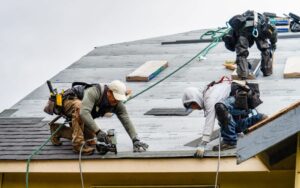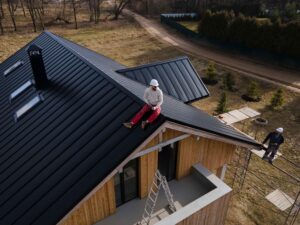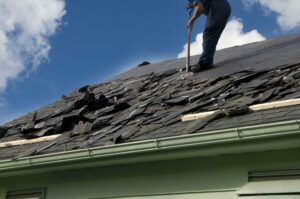When it comes to saving money on a new roof, it’s essential to understand the various factors that influence costs. From warranties and insurance coverage to the timing of your replacement, there are several strategies you can employ. Exploring local contractors and examining financing options can also make a significant difference. By knowing when to repair instead of replace, you can maximize your savings. Let’s explore these options in more detail.
Understanding Roofing Costs
When you’re considering a new roof, understanding the costs involved can help you make informed decisions and avoid unexpected expenses. Roof replacement typically ranges from $5,000 to $25,000, so it’s essential to verify if your roof is still under warranty or if your insurance covers the costs. Take into account the age and visible damage, such as leaks, that may necessitate a replacement. Additionally, inflation has driven up material costs by 22-25% in just a year, so timing matters. Planning your replacement during off-peak seasons may yield better rates. Regular inspections can also help you spot issues early, preventing larger expenses down the line. Evaluate your market for best timing to protect your investment.
Smart Ways to Reduce Roof Replacement Costs
Finding ways to reduce roof replacement costs can save you a significant amount of money while guaranteeing your home remains protected. Start by checking your warranty and insurance; you might be able to claim costs if your roof is still covered. Timing matters too—schedule your replacement during off-peak seasons to take advantage of lower labor rates. Regular inspections help you assess your roof’s condition, potentially saving you from costly full replacements. Choose cost-effective roofing materials that balance quality and affordability, avoiding unnecessary upgrades. Finally, obtain detailed estimates from contractors to guarantee transparency and avoid hidden costs. By following these smart strategies, you can effectively lower your roof replacement expenses without sacrificing quality or safety.
Use Local Roofing Contractors
Using local roofing contractors can greatly impact both the cost and quality of your roof replacement. Local contractors often have a deep understanding of regional weather patterns and building codes, guaranteeing your roof is built to last. They typically offer competitive pricing, helping you save on labor and materials. By choosing a local company, you can benefit from their reputation within the community, often resulting in better service and accountability. Plus, local contractors often provide quicker response times for inspections and repairs, which can prevent further damage and costs. Confirm you verify their licenses and insurance, and request detailed estimates to avoid surprises. Overall, this choice can lead to a more satisfactory roofing experience.
Financing, Rebates, and Tax Incentives
Exploring financing options, rebates, and tax incentives can greatly ease the financial burden of a new roof. Start by checking your warranty or consulting your insurance—some costs might be covered. Next, look into local and federal tax incentives for energy-efficient upgrades. Many utility companies offer rebates for using high-efficiency materials, which can lessen upfront costs. Additionally, consider financing options like home equity loans or contractor financing plans that spread payments over time. Timing your roof replacement during off-peak seasons can also lead to better rates. By combining these strategies, you can considerably reduce the overall expense of your new roof while enhancing your home’s value and energy efficiency.
DIY Tasks That Can Save You Money
While managing the costs of a new roof can feel challenging, there are several DIY tasks you can tackle to save money and extend the life of your existing roof. Start by inspecting shingles for curling or cracks; addressing these early can prevent bigger issues. Regularly clean your gutters to avoid water damage, and remove debris from the roof to maintain drainage. Document any damage you find to discuss with contractors later. If you notice minor leaks, consider applying roof sealant as a temporary fix. Additionally, keeping a schedule for regular inspections will help you catch problems before they escalate. These proactive measures can greatly lower repair costs and prolong your roof’s lifespan.
Know When to Repair Instead of Replace
Knowing when to repair your roof instead of replacing it can save you significant money and extend its lifespan. Start by inspecting your shingles for curling, cracking, or missing pieces. If your roof shows minor wear, consider repairs rather than a full replacement. Check your warranty or insurance; repairs may be covered. Document any damage to discuss with contractors to guarantee you receive the right advice. Regular inspections can prevent costly issues down the line, and addressing minor repairs promptly is essential. If you notice visible leaks or extensive damage, it might be time for a replacement. Ultimately, balancing the cost of repairs with potential long-term savings will guide your decision on whether to repair or replace.
Frequently Asked Questions
How Can I Choose the Right Roofing Material for Cost Savings?
To choose the right roofing material for cost savings, consider durability, maintenance needs, and energy efficiency. Research options like asphalt shingles or metal roofing, and consult with professionals to assess your specific requirements and budget.
What Are the Best Seasons for Roof Replacement to Save Money?
The best seasons for roof replacement are typically spring and fall. During these times, weather conditions are milder, allowing for efficient work. You’ll often find better pricing and scheduling flexibility with contractors as well.
Can I Negotiate Prices With Roofing Contractors?
Yes, you can negotiate prices with roofing contractors. Start by researching average costs, gathering multiple quotes, and discussing your budget openly. Many contractors appreciate transparency and may offer discounts or flexible payment options to secure your business.
Are There Hidden Costs in Roofing Contracts I Should Watch For?
When reviewing roofing contracts, check for hidden costs like permit fees, disposal charges, or unexpected material upgrades. Clarify every line item with the contractor to avoid surprises and guarantee you understand the total investment required.
How Often Should I Get My Roof Inspected to Prevent Costly Repairs?
You should get your roof inspected at least once a year. Regular inspections can catch minor issues early, preventing costly repairs down the road. Always check after severe weather to ascertain everything’s in good condition.




